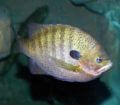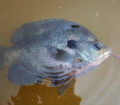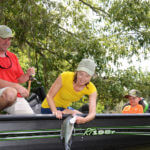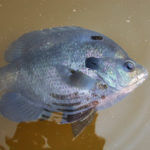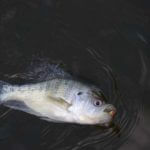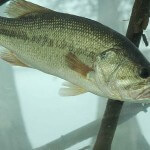Editor’s Note: I like to fish for eaters. As a child, I fished with my father on almost every day off he had. We fished on nearby rivers and lakes, caught a wide variety of fish, cleaned our catch and took them home for my mother to cook for supper. Eating what we caught extended our fishing fun and provided delicious food for our family. Let’s look at some ways to find and catch more catfish and bluegills.
 Bluegill Beds: My friend, the late Walton Lowry of Birmingham, Alabama, caught more bluegills than just about any other angler I ever knew. Paddling around the edge of a farm pond, he practically seined all the bluegills out of a pond by utilizing a very-deadly bluegill tactic almost every week during the spring and summer.
Bluegill Beds: My friend, the late Walton Lowry of Birmingham, Alabama, caught more bluegills than just about any other angler I ever knew. Paddling around the edge of a farm pond, he practically seined all the bluegills out of a pond by utilizing a very-deadly bluegill tactic almost every week during the spring and summer.
Lowry would sit on front of the boat with a fly rod and a small chartreuse-colored popping bug and fly-fish around the edge of the bank. “I float all the way around the pond one time to locate the hot spots,” Lowry told me once. “I make mental notes of where I catch bluegills. Then I know where the bluegills are bedding and concentrate my fishing on those spots.”
Many times Lowry caught fish on the surface in locations that helped him know that the bream at that site held close to the bank. Then he’d concentrate his fishing in the shallow-water places. Or, if he caught bluegills well away from the bank in 3-4 feet of water, he’d use deep-water tactics to produce the most bluegills off the bed.
By circling the pond as soon as he arrived, Lowry would locate all the bluegill beds he wanted to fish that day. Concentrating his fishing on these beds meant he caught more bluegills faster than if he’d used other techniques. When one bluegill bed quit producing, he’d move to another bed and fish until the bluegills on that bed quit biting. Switching the beds he fished throughout the day and then returning to the beds he’d fished before, he constantly was fishing where the bluegills were actively feeding.
Boathouse Bluegills: Anglers know boathouse bream may be the most-educated panfish in any reservoir, but May and June often will be the most-productive times of the year to catch these bream. Little bluegills often will run in and hit any baits that fall in the water. But the larger, older gills usually will stay just below or off to one side of a school of small fish and observe what happens when the smaller fish feed. Generally if big bluegills are in a boathouse, and little fish are in that same area, the smaller bluegills will get caught, and the trophy-sized fish won’t. If you want to succeed in catching the boathouse bluegills that have tantalized others and escaped the skillet, try these strategies this week. They will produce for you.
The common mistakes made by most anglers when fishing for bigger-than-average-boathouse bluegills are they fish:
* Line that’s too heavy;
* Hooks and bait that are too big;
* Their corks where they hold the baits off the bottom; rather than allowing the baits to fall to the bottom; and
* Too close to the bluegills.
 Boathouse bluegills often will be the biggest sunfish in a lake. These fish have easy-to-get meals anytime anglers are at the dock. Most anglers empty out bait cups, drop pieces of biscuits and dispose of partially-eaten candy bars either before they leave the boathouse in the morning, or when they return to the boathouse in the evening. Boathouses are also home to large numbers of spiders, minnows and bugs on which the bigger bluegills feed. The pilings and boats in the boathouse provide shade and ambush points for these predators. Also a boathouse provides an opportunity for the bluegills to study anglers.
Boathouse bluegills often will be the biggest sunfish in a lake. These fish have easy-to-get meals anytime anglers are at the dock. Most anglers empty out bait cups, drop pieces of biscuits and dispose of partially-eaten candy bars either before they leave the boathouse in the morning, or when they return to the boathouse in the evening. Boathouses are also home to large numbers of spiders, minnows and bugs on which the bigger bluegills feed. The pilings and boats in the boathouse provide shade and ambush points for these predators. Also a boathouse provides an opportunity for the bluegills to study anglers.
You can catch boathouse bluegills by using a technique no other angler utilizes. Bury a small hook inside a large redworm, attach it to 4-pound-test line, spray the worm with Spike-It’s Aerosol Fish Attractant in Crawfish or Gamefish flavors (www.ispikeit.com), and lay the worm on a step going from the dock down into the boathouse. Then hide behind the outer wall of the structure. Pull enough line off from the ultralight reel and through the rod to coil the line beside the worm on the edge of the step. Once the angler’s convinced the bluegills can’t see him, then he can take the rod tip and give the worm and the line a nudge so the worm will fall off the side of the step and into the water. Because no lead or cork is on the line as the bait falls, the line doesn’t restrict the worm’s descent. The bait hits the water, free-falling to the bottom naturally. From the hiding place, watch the line at the end of the rod. Once there’s a sharp tick on the line, set the hook, and reel in the big boathouse bluegill.
This tactic can be slightly modified later when fishing from a dock. Utilizing a clear, plastic cork as a weight for the line and no lead, cast close to a boathouse with a worm sprayed with Spike-It A erosol Fish Attractant covering the hook. When the bluegill looks up, it can’t spot the cork sitting on the water because the bobber is made of clear plastic. All the fish can see is a worm slowly squirming its way to the bottom. Then the bluegill attacks. This strategy works.
erosol Fish Attractant covering the hook. When the bluegill looks up, it can’t spot the cork sitting on the water because the bobber is made of clear plastic. All the fish can see is a worm slowly squirming its way to the bottom. Then the bluegill attacks. This strategy works.
To learn recipes for cooking bream and other freshwater fish, check out John E. Phillips’ Kindle cookbook, “13 Freshwater Fish Recipes You Can’t Live Without” at http://amzn.to/18OiC9v. For information on any type of fishing, visit https://johninthewild.com/books.

